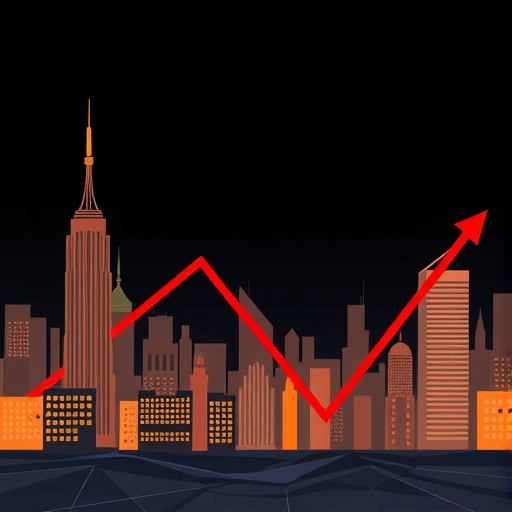Navigating Downside Markets: A Comprehensive Guide to Inverse ETFs
In the dynamic world of finance, while many investors focus on profiting from rising markets, have you ever wondered how to potentially benefit when markets decline? A unique class of financial instruments offers precisely this opportunity: Inverse Exchange-Traded Funds (ETFs). These specialized funds are designed to deliver returns that move in the opposite direction of a specified underlying asset or market index, allowing for strategic plays in bearish environments. However, their sophisticated mechanics and inherent risks demand a thorough understanding before considering them for your investment portfolio.

In this comprehensive guide, we will delve into the intricacies of Inverse ETFs, exploring how they function, their distinct advantages, and their significant limitations. We’ll also examine the various types available, their applications for tactical trading, and the cautious stance of financial regulators. Finally, for those with more experience, we’ll touch upon advanced strategies like generating income with Inverse ETF covered calls. Our goal is to equip you with the knowledge to understand these complex products, emphasizing that they are not suitable for every investor.
This guide aims to cover several key areas related to Inverse ETFs:
- Understanding the core mechanics and operational principles of these unique funds.
- Weighing their distinct advantages against the inherent risks and limitations.
- Exploring the diverse range of Inverse ETFs available and their practical market applications.
- Examining the regulatory oversight and investor suitability guidelines.
What Are Inverse ETFs and How Do They Operate?
At its core, an Inverse ETF is an investment fund traded on stock exchanges, much like a regular stock. But unlike traditional ETFs that track an index’s upward movement, Inverse ETFs aim to deliver performance that is the opposite of a specific underlying asset or market index. This is why they are often referred to as “bear ETFs” or “short ETFs.” Imagine a seesaw: if the market goes up, the Inverse ETF goes down, and if the market goes down, the Inverse ETF aims to go up.
To further illustrate the fundamental difference between traditional and inverse ETFs, consider the following comparison:
| Feature | Traditional ETF | Inverse ETF |
|---|---|---|
| Market Direction Aim | Profits from rising markets | Profits from falling markets |
| Tracking Mechanism | Directly holds underlying assets (stocks, bonds) | Primarily uses derivatives (options, futures, swaps) |
| Typical Use Case | Long-term growth, diversification | Short-term speculation, hedging against downturns |
How do they achieve this inverse performance? Inverse ETFs do not directly hold the underlying assets. Instead, they primarily use a basket of complex financial contracts known as derivatives, such as options, swaps, and futures contracts. These derivatives are expertly managed by the fund to create a position that profits when the underlying index or asset falls. For instance, an Inverse S&P 500 ETF would use derivatives to effectively “short” the S&P 500 index, aiming for a return that is the inverse of the index’s daily performance.
Some of the common types of derivatives used by Inverse ETFs to achieve their objectives include:
- Futures Contracts: Agreements to buy or sell an asset at a predetermined price on a future date. Inverse ETFs often short futures contracts on the underlying index.
- Options: Contracts that give the holder the right, but not the obligation, to buy or sell an underlying asset at a specified price. Inverse ETFs might use put options to gain from declines.
- Swaps: Agreements between two parties to exchange financial instruments, interest rates, or cash flows. Inverse ETFs may use total return swaps to gain inverse exposure to an index.
A crucial characteristic of Inverse ETFs is their daily rebalancing. Most Inverse ETFs are designed to achieve their inverse performance objective on a *daily* basis. This means the fund resets its exposure at the end of each trading day. While this helps them maintain their inverse correlation over short periods, it introduces a significant risk known as the compounding effect or “volatility decay” over longer periods. If the market fluctuates up and down repeatedly, the Inverse ETF’s performance over weeks or months can significantly diverge from the simple inverse of the underlying asset’s cumulative return.

Furthermore, some Inverse ETFs are leveraged ETFs, meaning they aim to provide amplified inverse returns. For example, a “2x” Inverse ETF seeks to return twice the inverse of the daily movement of the underlying asset, while a “3x” Inverse ETF aims for three times the inverse. While this amplifies potential gains, it also dramatically amplifies potential losses, making these funds even riskier and highly sensitive to market volatility. These instruments are truly designed for short-term trading, often for a single day, and are not suitable for “buy-and-hold” investment strategies.
The leverage factor in Inverse ETFs directly scales the daily inverse performance:
- A 1x Inverse ETF aims to move -1% for every +1% movement in the underlying index.
- A 2x Inverse ETF aims to move -2% for every +1% movement in the underlying index.
- A 3x Inverse ETF aims to move -3% for every +1% movement in the underlying index.
Advantages and Risks: Weighing Inverse ETFs Against Short Selling
Why would an investor choose an Inverse ETF over traditional short selling? Inverse ETFs offer several distinct advantages that make them more accessible for many traders. Firstly, they are easier to buy and sell through regular brokerage accounts, much like any other stock or ETF. You typically don’t need a specialized margin account, which is often required for short selling. Secondly, with an Inverse ETF, your potential losses are generally limited to the amount you invested, unlike theoretical unlimited losses that can occur when short selling a stock that continually rises. This simplicity and defined risk profile can be appealing.
Here’s a brief comparison highlighting key differences between Inverse ETFs and traditional short selling:
| Feature | Inverse ETFs | Short Selling |
|---|---|---|
| Accessibility | Easily traded in standard brokerage accounts. | Often requires a margin account and specific permissions. |
| Loss Potential | Limited to initial investment. | Theoretically unlimited as stock price can rise indefinitely. |
| Complexity | Mechanism (derivatives, daily rebalancing) is complex. | Requires understanding margin calls, borrow rates, and dividend obligations. |
| Daily Reset Effect | Significant “volatility decay” over longer periods. | Not directly applicable; profit/loss is cumulative. |
However, these advantages come with a significant set of risks and limitations that make Inverse ETFs unsuitable for most long-term investors. We cannot emphasize enough that these are not “set it and forget it” investments. Let’s explore the key risks:
- Daily Reset and Compounding Effect (Volatility Decay): As mentioned, Inverse ETFs reset daily. This means their performance over periods longer than a single day can significantly deviate from the simple inverse of the underlying index. Imagine a market that goes up 5% one day and down 5% the next. The underlying asset ends flat. A perfectly inverse ETF aiming for daily inverse returns would have lost money on both days due to the compounding effect, resulting in a loss for the two-day period, even if the market ultimately went nowhere. This “volatility decay” makes them poor choices for long-term holding.
- High Volatility: Especially true for leveraged Inverse ETFs, these funds can experience amplified gains and losses. A small misjudgment in market direction can lead to substantial and rapid capital erosion.
- Tracking Error: Due to management costs, market inefficiencies, and the complexities of derivative trading, Inverse ETFs may not perfectly mirror the inverse movement of their underlying index. There can be a “tracking error” between the fund’s stated objective and its actual performance.
- Higher Expense Ratios: Managing a portfolio of derivatives is more complex and expensive than managing a portfolio of stocks. Consequently, Inverse ETFs typically have higher expense ratios (annual fees) compared to traditional ETFs. These costs eat into your returns.
- Market Timing is Crucial: Profiting from Inverse ETFs requires an accurate prediction of short-term market direction. If your timing is off, even by a day, you can incur significant losses. This makes them highly speculative.
In summary, while Inverse ETFs provide an alternative to short selling with some accessibility benefits, their inherent structure, reliance on daily rebalancing, and amplified risks mean they are designed for sophisticated, active traders with a clear short-term view on market trends. They are explicitly warned against for long-term “buy-and-hold” investors by financial experts and regulatory bodies.
Types of Inverse ETFs and Their Market Applications
The world of Inverse ETFs is diverse, offering options to bet against various segments of the market. Understanding these types helps you identify how they can be applied in different investment scenarios. We can categorize them based on their leverage and the underlying assets they track:
By Leverage:
- Standard Inverse ETFs (1x): These aim for an exact inverse of the daily return of the underlying asset or index. For example, if the S&P 500 drops 1% today, a standard Inverse S&P 500 ETF aims to gain 1% today.
- Leveraged Inverse ETFs (2x, 3x): These funds seek to provide amplified inverse returns, such as 200% or 300% of the inverse daily movement. For instance, a 2x Inverse NASDAQ-100 ETF would aim to gain 4% if the NASDAQ-100 falls 2% in a single day. Examples include ProShares UltraPro Short QQQ (SQQQ) or Direxion Daily Semiconductor Bear 3x Shares (SOXS).
By Underlying Asset/Market:
- Equity-Based Inverse ETFs: These track broad market indices or specific sectors.
- Broad Market Indices: Funds that inversely track major indices like the S&P 500 (e.g., ProShares Short S&P 500 – SH), NASDAQ-100 (e.g., ProShares UltraPro Short QQQ – SQQQ), Dow Jones Industrial Average (e.g., ProShares Short Dow 30 – DOG), Russell 2000 (e.g., ProShares Short Russell 2000 – RWM), or even international markets like the MSCI Emerging Markets.
- Sector-Based: These target specific market sectors such as technology, energy, or financials. For example, Direxion Daily Semiconductor Bear 3x Shares (SOXS) aims to inversely track the semiconductor industry.
- Commodity and Bond Inverse ETFs: These track the inverse movements of commodities or bonds.
- Commodity-Based: Funds that move inversely to commodities like crude oil (e.g., Global X BetaPro Crude Oil Inversed Leveraged Daily Bear ETF – HOD), natural gas (e.g., ProShares UltraShort Bloomberg Natural Gas – KOLD), or gold miners (e.g., Direxion Daily Gold Miners Index Bear 2x Shares – DUST).
- Bond-Based: Inverse ETFs that track bond markets, aiming to profit when bond prices fall (and yields rise), such as ProShares Short 20+ Year Treasury (TBF).
- Single-Stock Inverse ETFs: A newer and highly specialized category that tracks the inverse performance of individual company stocks. Examples include those tracking companies like Tesla (TSLA) (e.g., TSLQ) or Nvidia (NVDA) (e.g., NVDS). These are incredibly specific and carry amplified individual stock risk.
- Cryptocurrency-Based Inverse ETFs: With the rise of digital assets, some Inverse ETFs now track cryptocurrencies like Bitcoin (e.g., Global X BetaPro Inverse Bitcoin ETF – BITI), offering a way to speculate on their price declines.
Market Applications:
So, how do active traders typically use these Inverse ETFs?
- Hedging: One primary application is hedging. If you hold a long-term portfolio of stocks and anticipate a short-term market downturn, you might buy an Inverse ETF to offset potential losses in your main portfolio. This acts as a form of “insurance” without having to sell your existing holdings.
- Short-Term Speculation: Experienced traders use Inverse ETFs for short-term speculation, aiming to profit directly from anticipated market declines or specific asset weaknesses. For example, if you believe the technology sector is due for a pullback, you might invest in a sector-specific Inverse ETF for a few days. This allows traders to capitalize on bearish market trends.

It’s crucial to reiterate that these applications are almost exclusively for short-term strategies. The daily reset mechanism makes them ill-suited for long-term capital appreciation or protection.
Regulatory Landscape and Investor Suitability
Given their complex structure and inherent risks, financial regulatory bodies around the world have adopted a cautious stance regarding Inverse ETFs, particularly concerning their suitability for retail investors. Their warnings are a critical aspect of understanding these specialized products.

In the United States, the U.S. Securities and Exchange Commission (SEC) has repeatedly issued investor alerts about Inverse ETFs. The SEC describes them as “specialized products with extra risks for buy-and-hold investors.” Their primary concern stems from the daily rebalancing feature, which, as we discussed, causes performance to diverge significantly from the inverse of the underlying index over periods longer than a single day due to the compounding effect. The SEC emphasizes that these ETFs are designed for sophisticated investors who actively monitor and manage their positions, often on a daily basis. They are not recommended for investors with long-term goals or those who do not fully understand the risks associated with derivatives and daily compounding.
The regulatory environment in other regions can be even stricter. For instance, in India, the Securities and Exchange Board of India (SEBI) currently prohibits Inverse ETFs for retail investors. SEBI’s decision is driven by a range of concerns aimed at protecting retail investors and maintaining market stability. These concerns include:
- Market Volatility: The amplified nature of leveraged Inverse ETFs can exacerbate market swings.
- Retail Investor Protection: SEBI believes the complexity and high risk of these instruments make them unsuitable for the average retail investor, who may not fully grasp the potential for rapid losses.
- Complexity and Transparency: The derivative-heavy structure can make it difficult for investors to understand exactly how the fund generates its returns and what its true exposure is.
- Fund Management Challenges: Managing these funds effectively in volatile markets presents significant challenges for fund houses.
This prohibition by SEBI highlights a global trend among regulators to shield less experienced investors from products deemed too complex or too risky for their typical investment horizons. It underscores the message that Inverse ETFs are not for everyone.
Who, then, are Inverse ETFs suitable for? They are generally appropriate for experienced traders, often day traders, who have a deep understanding of market dynamics, derivatives, and sophisticated trading strategies. These traders must be capable of precise market timing and active management, as holding these funds for more than a day can lead to unexpected and substantial losses, even if their initial market prediction was correct in the short term. For the vast majority of investors, particularly those with a long-term investment horizon or a “buy-and-hold” strategy, Inverse ETFs should be approached with extreme caution, if at all.
A summary of investor suitability for Inverse ETFs is provided below:
| Investor Type | Suitability for Inverse ETFs | Key Considerations |
|---|---|---|
| Experienced Traders/Day Traders | Highly suitable for short-term, tactical trading. | Requires accurate market timing, active management, and understanding of derivatives. |
| Sophisticated Investors (e.g., institutional) | Potentially suitable for hedging or complex strategies. | Used as part of a broader, well-understood portfolio strategy. |
| Retail Investors (Long-term horizon) | Not suitable; explicitly warned against by regulators. | Risk of significant losses due to compounding effect and volatility decay over time. |
Advanced Strategies: Generating Income with Inverse ETF Covered Calls
For sophisticated investors and active traders seeking to enhance returns or generate income, an advanced strategy involves writing covered calls on Inverse ETFs. This strategy leverages the unique characteristics of Inverse ETFs to potentially profit in falling or stagnant markets, offering a non-correlated investment opportunity to traditional long portfolios. While this strategy is more complex, understanding its mechanics can open new avenues for income generation.
First, let’s briefly review a covered call. A standard covered call involves owning 100 shares of a stock and selling (or “writing”) a call option against those shares. You collect a premium for selling the call. If the stock price stays below the strike price, the option expires worthless, and you keep the premium as income. If the stock rises above the strike price, your shares might be “called away” (sold) at the strike price, limiting your upside but you still keep the premium.
Now, apply this to an Inverse ETF. Instead of owning shares of a company, you own units of an Inverse ETF. Since an Inverse ETF is designed to increase in value when the underlying market or asset goes down, writing a covered call on an Inverse ETF allows you to potentially:
- Earn Income from Time Premium: Just like with regular covered calls, you receive a premium when you sell the call option. This premium provides immediate income, regardless of market movement.
- Profit from Falling Markets (Indirectly): If the underlying market (which the Inverse ETF is designed to inverse) falls, the Inverse ETF itself would rise in value. If the Inverse ETF’s price rises but stays below your call option’s strike price, you profit from both the increase in the ETF’s value and the collected premium.
- Benefit from Volatility: While high volatility can be a risk for simply holding Inverse ETFs, it can be beneficial for selling options, as higher volatility often leads to higher option premiums.
This strategy offers a potential way to generate income, particularly in market environments where you anticipate a decline or sustained weakness in a specific sector or index. It can provide a non-correlated investment stream, meaning its performance might not move in lockstep with your main, long-only portfolio. For example, if you hold a portfolio of tech stocks but anticipate a short-term tech sector downturn, you could buy an Inverse Technology ETF and write covered calls against it. If the tech sector declines, your Inverse ETF gains value, and you collect premiums, potentially offsetting losses in your long tech holdings.
However, there are important considerations. The option premiums for Inverse ETFs might be smaller compared to individual stocks, especially highly volatile ones, because ETFs are often less volatile than single company shares. Furthermore, the inherent complexities and risks of Inverse ETFs themselves, such as volatility decay and the need for accurate market timing, are still present. This strategy is therefore only recommended for highly experienced investors who are comfortable with both options trading and the unique characteristics of Inverse ETFs.
Conclusion
Inverse Exchange-Traded Funds (ETFs) represent a powerful, albeit complex, tool for experienced investors and active traders seeking to capitalize on or hedge against market downturns. They provide an accessible alternative to traditional short selling, allowing you to potentially profit when asset values decline without the need for a margin account or the risk of theoretically unlimited losses. Their ability to offer amplified returns through leverage further enhances their appeal for those with a strong conviction on short-term market direction.
However, the unique mechanics of Inverse ETFs, particularly their daily rebalancing and reliance on derivatives, necessitate careful consideration and a disciplined approach. The compounding effect or volatility decay means they are explicitly unsuitable for long-term “buy-and-hold” strategies, as their performance can significantly diverge from the intended inverse over extended periods. High expense ratios, tracking error, and the crucial need for accurate market timing add further layers of risk.
Regulatory bodies like the U.S. Securities and Exchange Commission (SEC) and the Securities and Exchange Board of India (SEBI) have highlighted these substantial risks, with SEBI even prohibiting them for retail investors in India, underscoring their speculative and complex nature. While advanced strategies like writing covered calls on Inverse ETFs can offer additional income opportunities for sophisticated investors, they also require a deep understanding of both options and the underlying ETF’s behavior.
In summary, understanding the unique structure and limitations of Inverse ETFs is paramount to leveraging them effectively within a strategic investment framework. Novice investors should exercise extreme caution and seek professional financial advice before considering these instruments, as the risks associated with them can lead to rapid and substantial losses if not managed expertly. They are truly tools for tactical trading, not for passive investment.
Disclaimer: This article is for informational and educational purposes only and does not constitute financial advice. Investing in Inverse ETFs involves significant risks, including the potential loss of principal. Always consult with a qualified financial professional before making any investment decisions.
Frequently Asked Questions (FAQ)
Q: What is the main difference between an Inverse ETF and a traditional ETF?
A: The main difference lies in their objective: a traditional ETF aims to mirror the performance of an underlying asset or index, typically profiting when it rises, while an Inverse ETF is designed to move in the opposite direction, aiming to profit when the underlying asset or index declines.
Q: Why are Inverse ETFs generally not recommended for long-term investors?
A: Inverse ETFs are not suitable for long-term investors primarily due to their daily rebalancing mechanism, which leads to a “compounding effect” or “volatility decay.” This means their performance over periods longer than a single day can significantly diverge from the simple inverse of the underlying asset’s cumulative return, leading to unexpected losses.
Q: Can Inverse ETFs be used for hedging a long-term portfolio?
A: Yes, experienced traders sometimes use Inverse ETFs for short-term hedging purposes. If they anticipate a brief market downturn, they might buy an Inverse ETF to temporarily offset potential losses in their long-term holdings without having to sell their core investments. However, this is a short-term tactical move, not a long-term strategy.



No responses yet